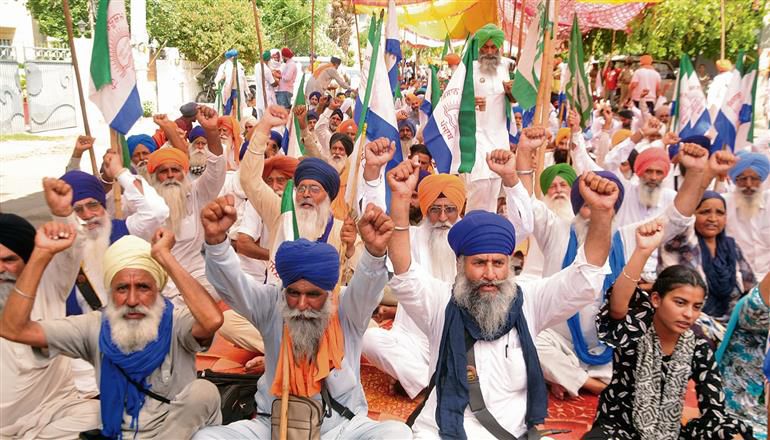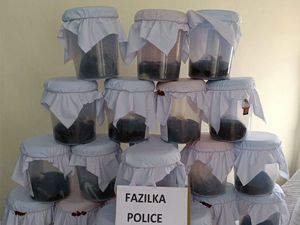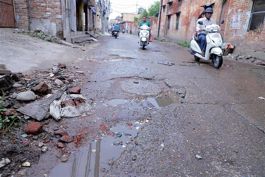
Farmers under the banner of Samyukt Kisan Morcha (non-political) protest outside BJP candidate Taranjit Singh Sandhu’s house in Amritsar.
Charanjit Singh Teja
and Rajmeet Singh
Tribune News service
Amritsar/Chandigarh, May 28
Farmer unions are worried that the poll campaign in Amritsar may end up driving a wedge between Mazhabi Sikhs and Jat Sikhs, the major rural communities.
On Monday, BJP’s Amritsar candidate Taranjit Singh Sandhu called farmer leaders “besharam” for stopping him from meeting a Dalit family, and this has set the alarm bells ringing among farm unions.
The saffron party is attempting to polarise Dalit and Jat votes. Its leaders are trying to sow hatred and poison in Punjab. Swaran Singh Pandher, Samyukt Kisan Morcha
“The BJP is attempting to polarise Dalits against Jats in state politics, and they’re trying to sow the same hatred and poison in villages. They are trying to become ‘Messiah’ of Dalits,” says Swaran Singh Pandher of the Samyukt Kisan Morcha (non-political).
Farm leaders fear that with the narrative that Kisan Unions are promoting only the interests of Jats, the poll campaign might end up enlarging the divide between Mazhabi Sikhs and Jat Sikhs.
Going solo for the first time in Punjab after parting ways with Shiromani Akali Dal (SAD), the BJP’s poll campaign in Amritsar is giving sleepless nights to the Jat Sikh-dominated farm unions, which have been organising protests against the candidates of the saffron party.
The BJP had tried this strategy of caste divide in Haryana — where the party focused primarily on non-Jat voters, relying on the Other Backward Classes (OBCs) — and the party is implementing it in Punjab. This is significant as Dalits comprise nearly 35 per cent vote share in the state — the maximum in any state in the country — compared to just 18 per cent of Jat voters.
Political observers say that not only in Amritsar, the party is trying to achieve the polarisation of votes along caste lines, thus splitting the Sikh vote. This is especially true in Mazhabi Sikh-dominated areas in Majha and Malwa regions, where the party is focusing on Mazhabi Sikhs in rural areas and Balmikis in urban areas, making them sensitive to the “Jat dominance” of state politics.
“It is not only Jat versus Mazhabi Sikhs. The party is using the already existing differences between the Mazahbi/ Balmikis and the Ravidassia/ Ramdasia communities over their share in job reservations. The Ravidassia/Ramdassia communities do not vote for the BJP. So, polarising the Mazhabi Sikhs in rural areas and Balmikis in urban areas could benefit the BJP,” points out a poll strategist.
The divide is becoming increasingly evident on the ground. Jaswider Singh, a BJP activist from Jahangir village, said: “The SC community got attracted towards the BJP with the welfare schemes being offered by PM Modi.”
There are 39 sub-castes among Dalits in Punjab. Mazhabi Sikhs/Balmikis comprise 13 per cent of the Dalit vote share. The Ramdassia Sikh, Ravidassia and Ad-dharmi comprise 13.5 per cent vote share, while the remaining vote share lies with other sub-castes.
The divide among the Mazhabi Sikhs and Jats would mainly affect the Shiromani Akali Dal — not only in the ensuing Lok Sabha polls, but in future elections too. Mazhabi Sikhs have traditionally supported the Congress whereas the SAD has a strong support base among Jat farmers.
During the 2007-17 SAD regime, freebies and welfare schemes offered by the government appeased the Dalits. However, the next Congress government, led by Amarinder Singh, failed to please Mazhabi Sikhs, even though the Congress gave the state its first Dalit CM — Charanjit Singh Channi, from the Ravidassia community. However, the move didn’t pay dividents as the AAP routed the Congress and SAD in 2022.
Mazhabi Sikhs are now pitted against the Ravidassia community, who have gone to court to challenge the 12.5 per cent reservation to Mazhabi Sikhs and Balmikis in government jobs. The Congress has gained the support of the Ravidassia community in the Doaba region, but overall, it has lost its grip over the Balmiki community in urban areas and Mazhabi Sikhs in rural areas.
At a recent meeting of Mazabhi Sikh and Balmiki community leaders, Baba Major Singh Sodhi of Dashmesh Tarna Dal of Nihangs asked the Congress to make efforts to ensure that the case of Mazhabi/Balmiki reservation is withdrawn from the Supreme Court — else the community will boycott Congress candidates (Channi in Jalandhar and Dr Amar Singh in Fatehgarh Sahib) in the Lok Sabha elections.
The SAD is trying to unite the Sikh vote by returning to the core panthic issues. With the BJP working on a diametrically opposing strategy, we’re in for interesting and possibly volatile times.
Join Whatsapp Channel of The Tribune for latest updates.



























